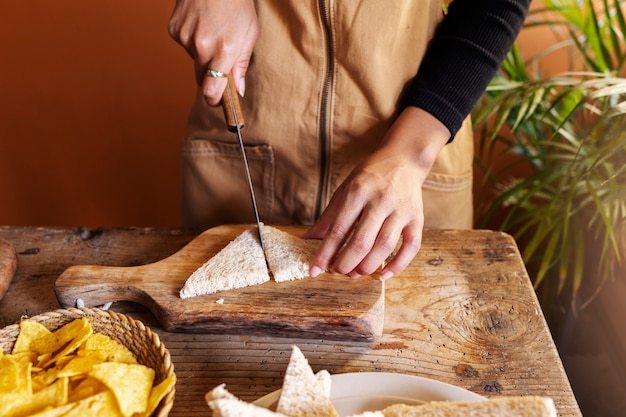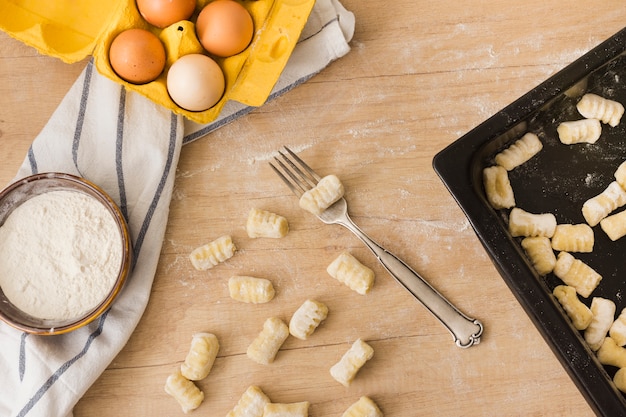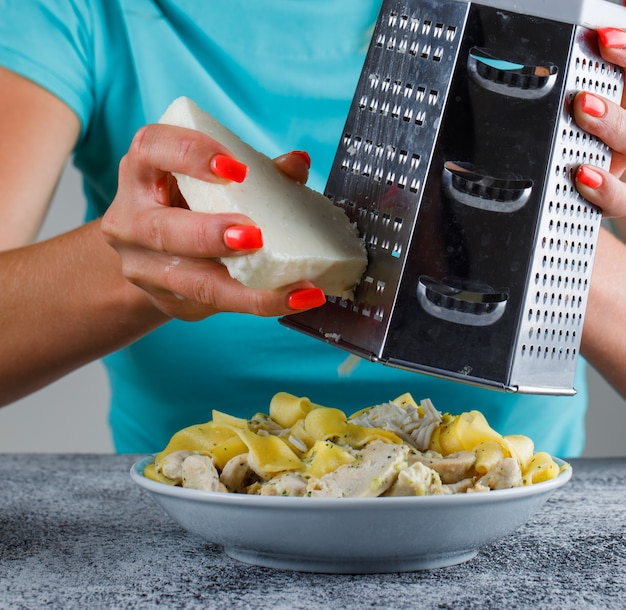There's a special kind of magic in biting into a perfectly cooked piece of pasta, that "al dente" texture where it's firm yet yielding, a dance between cooked and raw. It's a delicate balance, one I've struggled with in the past, resulting in my fair share of mushy pasta disasters. But over time, I've learned a few tricks, and I'm excited to share them with you. Let's dive into the world of fresh pasta cooking, starting with understanding the essence of "al dente."
Part 1: The Al Dente Quest: A Journey to Pasta Perfection

Imagine a beautifully crafted pasta dish: a vibrant sauce clinging to perfectly cooked pasta, each strand holding its shape, offering a delightful resistance with every bite. That's the magic of al dente pasta. It's not just about texture, though. Al dente pasta plays a crucial role in how your sauce interacts with it, enhancing flavour and creating a symphony of textures.
1. What is Al Dente?
Al dente, an Italian phrase meaning "to the tooth," describes the ideal texture of cooked pasta. It's a happy medium where the pasta is cooked through but still has a slight resistance when you bite into it. Imagine the pasta having a touch of "bite" left, a subtle springiness that adds to the overall experience. It's not raw, but it's not completely soft and mushy either.
2. Why Al Dente?
The key to a truly satisfying pasta dish lies in understanding the importance of al dente pasta. It's the foundation upon which the entire dish is built. Think of it like this: a perfectly crafted pasta sauce, bursting with flavour, deserves a partner that can truly showcase its brilliance. Overcooked pasta, on the other hand, becomes a soggy sponge, absorbing the sauce and creating a mushy mess. Al dente pasta, however, holds its own. It allows the sauce to cling to its surface, coating every strand, creating a harmonious balance of flavours and textures.
3. The Art of Achieving Al Dente
Now, the true art lies in achieving that al dente texture. It's not as straightforward as following the package instructions. There are several factors at play, including:
- Type of Pasta: Different shapes and sizes of pasta have different cooking times. Delicate spaghetti cooks much faster than thick, hearty fettuccine.
- Fresh vs. Dried: Fresh pasta, made with eggs and flour, cooks much faster than dried pasta. So, if you're using fresh pasta, be prepared for a shorter cooking time.
- water temperature: A rolling boil is crucial for even cooking. If the water isn't hot enough, the pasta will take longer to cook and might end up unevenly cooked.
- Pot Size: It's essential to use a large pot with ample water. This ensures enough space for the pasta to move freely and cook evenly. It also prevents the water temperature from dropping significantly when you add the pasta.
Part 2: The Pasta Dance: A Step-by-Step Guide to Fresh Pasta Perfection

Now, let's get our hands dirty and explore the process of cooking fresh pasta. Don't worry, it's simpler than you might think. With a little practice, you'll be a pasta pro in no time. Follow these steps, and you'll be on your way to creating delicious, al dente pasta dishes.
1. The Water is Your Canvas
Start by filling a large pot with plenty of water. Aim for at least 6 quarts or 6 litres of water for a pound of pasta. You want enough water to ensure the pasta has room to cook evenly and that the temperature remains consistent. Once the water is at a rolling boil, add a generous amount of salt. This not only adds flavour to the pasta but also helps prevent it from sticking together.
2. The Gentle Plunge
Carefully add the fresh pasta to the boiling water, being careful not to overcrowd the pot. If you're cooking a large quantity of pasta, consider doing it in two batches. Give the pasta a gentle stir with a wooden spoon to prevent it from sticking together.
3. The Timing is Key
This is where experience and a little intuition come into play. While there are general guidelines, the thickness of the pasta determines its cooking time. Check the pasta for doneness after about 2-3 minutes. I usually do a taste test. If it's still a bit firm, I give it another minute or two. It's all about finding that sweet spot where the pasta is cooked through but still has a slight bite.
4. The Gentle Drain
Once your pasta is cooked to your liking, use a colander to drain it. Don't just dump the pasta into the colander; gently lift it out using tongs to prevent it from sticking together. You've worked hard to achieve that perfect texture, so treat it with care.
Part 3: Beyond the Basics: Tips and Tricks for Pasta Mastery

Now that you've mastered the basics, let's dive into some insider tips and tricks that will elevate your pasta game to the next level. These are the subtle nuances that make a big difference.
1. Don't Overcrowd the Pot:
I can't emphasize this enough: give your pasta space! Overcrowding the pot can lead to uneven cooking and a sticky mess. Remember, you want the pasta to cook evenly and maintain its beautiful texture.
2. Invest in a Pasta Pot:
If you're a serious pasta lover, consider investing in a pasta pot. These pots have a built-in colander, making draining the pasta a breeze. No more juggling a heavy pot of boiling water over the sink! It's a game-changer, especially when you're dealing with large quantities of pasta.
3. Starchy Secrets: Saving the pasta water
This is a secret weapon that chefs use to enhance the flavour and creaminess of their pasta sauce. After draining your pasta, reserve a cup or two of the starchy pasta water. You can add this to your sauce to thicken it and give it a rich, velvety texture. The starch in the water acts as a natural thickener, creating a beautiful sauce that clings to the pasta perfectly.
4. Don't Rinse Your Pasta:
Rinsing your pasta after draining will wash away the precious starch that helps the sauce cling to the pasta. So, unless you're making a cold pasta salad, skip the rinsing step and let those starches work their magic.
Part 4: The Pasta Sauce Symphony: Creating a Harmonious Blend
With your perfectly cooked pasta ready, let's talk about the star of the show, the sauce. It's the element that truly transforms your pasta dish, adding complexity and depth of flavour. The world of pasta sauces is vast, from simple tomato sauces to rich, creamy pesto. There's a sauce for every mood and every palate. Remember, the sauce should complement the pasta, not overpower it. It's a harmonious blend, where each element shines through.
1. Classic Tomato Sauce:
This is a staple in my kitchen, a simple yet versatile sauce that can be dressed up or down depending on the occasion. The key to a good tomato sauce is patience. Simmer it slowly, allowing the tomatoes to break down and release their natural sweetness. You can add herbs, spices, a pinch of sugar to balance the acidity, or even a touch of balsamic vinegar for an extra layer of complexity. The possibilities are endless.
2. Creamy Pesto Sauce:
For a lighter and more refreshing option, try a creamy pesto sauce. The combination of fresh basil, pine nuts, Parmesan cheese, and olive oil is truly divine. This sauce is perfect for summer, a burst of freshness that complements the delicate texture of fresh pasta.
3. Creamy Carbonara Sauce:
A classic for a reason, Carbonara sauce is a rich, decadent delight made with eggs, Parmesan cheese, pancetta or guanciale (cured pork cheek), and black pepper. The key to a successful Carbonara is gentle cooking of the eggs. They should become creamy and silky, enveloping the pasta in a comforting embrace.
Part 5: The Pasta Serving Ritual: A Culinary Art Form
We've arrived at the moment where the magic truly unfolds, the culmination of all our efforts: serving the pasta. This is your chance to showcase your culinary artistry and make your pasta dish truly stand out. Remember, a little attention to detail goes a long way.
1. Don't Drown the Pasta in Sauce:
A delicate balance is key. You want just enough sauce to coat the pasta evenly, enhancing its flavour without overwhelming it. If you're using a chunky sauce, toss it gently with the pasta to avoid breaking the pasta strands.
2. Garnish with Love:
A sprinkle of fresh parsley, a drizzle of olive oil, or a grating of Parmesan cheese can elevate your pasta dish from good to spectacular. Don't be afraid to experiment with garnishes. A few slices of cherry tomatoes, a sprinkle of red pepper flakes, or a drizzle of balsamic vinegar can add pops of colour and flavour.
3. Serve Immediately:
Once the pasta is cooked and dressed, serve it immediately. This ensures that the pasta stays hot and the sauce remains creamy. No one wants lukewarm pasta! It's a matter of enjoying the dish at its peak, savouring the flavours and textures that you've worked so hard to create.
Part 6: The Fresh Pasta Advantage: A World of Difference
You might be thinking, "Fresh pasta sounds wonderful, but is it worth the extra effort?" And you're right, it does require a bit more effort than simply cooking dried pasta. But trust me, the results are worth every minute spent. Fresh pasta has a texture and flavour that simply can't be replicated with dried pasta. It's lighter, more delicate, and cooks up in a flash. It's a culinary experience that's both satisfying and rewarding.
1. Where to Find Fresh Pasta:
While you can certainly make your own fresh pasta, you can also find it at most Italian grocery stores and farmers' markets. If you're lucky, your local Italian restaurant might even sell leftover fresh pasta to customers. This is a great way to get your hands on fresh pasta without the hassle of making it yourself.
Part 7: The Pasta Journey: A Personal Reflection
I have a confession to make: I wasn't always a pasta aficionado. As a young person, I viewed pasta as simply a carbohydrate, nothing special. It wasn't until my first trip to Italy that I truly understood the magic of pasta. I tasted pasta dishes that were unlike anything I had ever experienced before. The pasta was perfectly al dente, the sauces were rich, flavourful, and full of soul. It was a revelation. Since then, I've become a pasta enthusiast, constantly experimenting with new recipes and discovering new ways to enjoy this classic dish. It's a journey that continues to this day, and I can't imagine my life without pasta.
Part 8: The Pasta Legacy: Sharing the Love
One of the things I love most about pasta is its ability to bring people together. It's a food that's universally loved and enjoyed, a perfect way to connect with friends and family. Whether it's a casual dinner party or a simple family meal, pasta always brings joy and satisfaction. I love sharing my pasta-making knowledge with others, seeing them discover the magic of fresh pasta and experience the same passion I have for this simple yet delicious food.
FAQs
1. How do you know when fresh pasta is done?
Fresh pasta cooks much faster than dried pasta. It's usually ready in about 2-3 minutes, depending on the thickness of the pasta. Look for a pasta that's no longer raw in the middle but still has a slight bite to it. You can always test a piece to see if it's cooked to your liking.
2. What if I overcook the fresh pasta?
Overcooked fresh pasta will become mushy and lose its texture. Don't fret, you can still try to salvage the situation. Adding more sauce might help absorb some of the excess liquid, and tossing it with grated Parmesan cheese or breadcrumbs can add some texture. But in the future, keep a close eye on the cooking time and be more cautious.
3. Can I freeze fresh pasta?
Yes, you can freeze fresh pasta. It's best to freeze it uncooked. Spread the pasta out on a baking sheet and freeze for about 30 minutes. Once it's frozen, transfer it to a freezer-safe bag. Fresh pasta can be frozen for up to 3 months. When you're ready to use it, cook it directly from frozen, adding a few minutes to the cooking time.
4. Is there a difference between fresh pasta and dried pasta?
Absolutely! Fresh pasta, made with eggs and flour, cooks quickly and has a lighter, more delicate texture than dried pasta. Dried pasta, made with durum wheat flour and water, has a chewier texture and requires a longer cooking time.
5. What are some good tips for making fresh pasta at home?
Here are a few pointers for making delicious fresh pasta at home:
- Use high-quality ingredients: fresh eggs, high-protein flour, and good olive oil make all the difference.
- Don't overwork the dough: Aim for a smooth and elastic dough, but avoid making it tough.
- Let the dough rest: This will help it relax and become easier to work with.
- Use a pasta machine: A pasta machine will ensure even, consistent sheets of pasta.
- Let the pasta dry slightly before cooking: This will help to prevent it from sticking together.
Part 9: The Endless Pasta Possibilities
The beauty of pasta is its versatility. There are countless ways to create delicious pasta dishes. Don't be afraid to experiment with different flavours, textures, and sauces. From simple weeknight dinners to elegant celebrations, pasta is a timeless food that's always a crowd-pleaser. So, embark on your pasta journey! Learn, explore, and most importantly, enjoy!
Everyone is watching

Prime Rib Roast Cooking Time Chart: Per Pound Guide
Cooking TipsPrime rib roast. Just the name conjures images of lavish dinners, crackling fires, and hearty laughter. It’s ...

How Long to Bake Potatoes in the Oven (Perfect Every Time)
Cooking TipsBaked potatoes are a staple in my kitchen. They're incredibly versatile, delicious, and surprisingly easy to m...

Perfect Rice Every Time: The Ultimate Guide to Cooking Rice
Cooking TipsAs a self-proclaimed foodie, I've always been a bit obsessed with rice. It's the foundation of countless cuisi...

The Ultimate Guide to Cooking Asparagus: Tips, Techniques, and Recipes
Cooking TipsAsparagus. The mere mention of this spring delicacy conjures up images of vibrant green spears, crisp and burs...

Ultimate Guide to Cooking the Perfect Thanksgiving Turkey
Cooking TipsThanksgiving. Just the word conjures up images of overflowing tables laden with delicious food, the scent of r...
